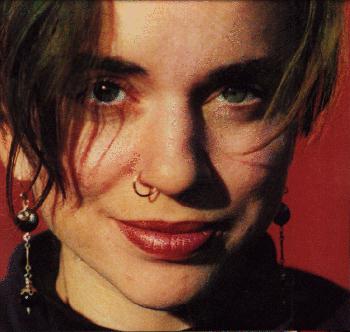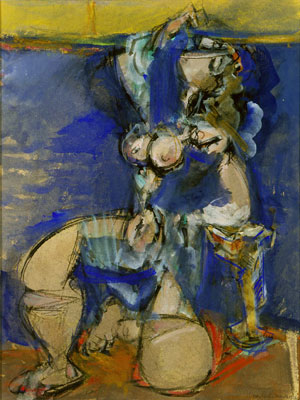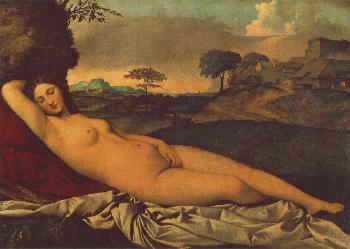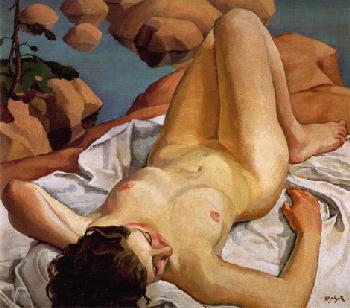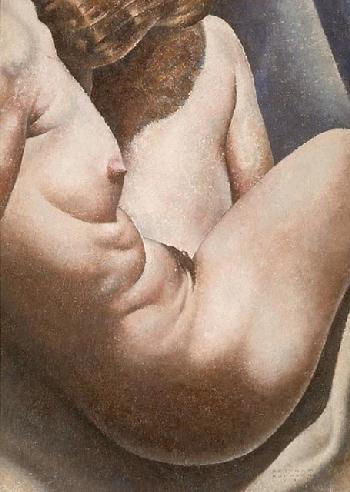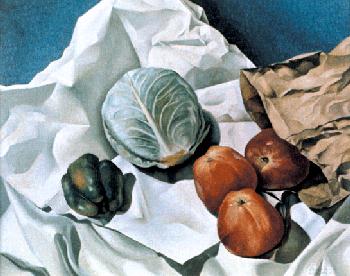| Nudes and Prudes
The Art History Archive - Canadian Art
By Bertram Brooker, 1931. Edited by Charles Moffat.
Editor's Note: Some grammatical/spelling changes have been made to the following document, which was written in 1931. English has actually changed a bit since 1931, and standards of grammar/spelling have actually improved. Brooker was 45 years old when he wrote this essay, and while his education was considered high by standards back then, he still made a number of grammatical and spelling errors (for example he used the word "profit" when he should have wrote "prophet"). Therefore, in instances where the spelling/grammar is lacking, I have corrected it in order to make a proper sentence.
You will also note the use of words and phrases that are not commonly used in today's writing and speech. For example, Brooker uses the word "Gradgrind", a term which is not found in a dictionary, but can be found in the books of Charles Dickens.
The essay itself is still very relevant to today's issues in art, because even today people continually struggle with the same questions. If anything, in this age of television, internet and mass media, the essay is even more relevant than ever. Brooker had no clue that mass media would become "the new religion" he envisioned in his essay, and the same issues that he was concerned about in art galleries back then is now our concerns when it comes to children looking at porn on the internet, nudity/lewdity on television (ie. The Simpsons, the early episodes are quite lewd) and expressive lyrics in music (like Ani DiFranco using the word "fuck" in her songs).
Special Thanks to Vladimira Zvonik and the University of Manitoba.
By David Helwig
It was 1931 in Toronto the Good, and a painting by Bertram Brooker was removed from the annual OSA exhibition by officers of the Art Gallery of Toronto. Nudes. Bertram Brooker had sent off a painting of nudes for exhibit—two nudes in one painting. Toronto quivered, shuddered, took it down.
And so: we look at this Bertram Brooker painting from the Confederation Centre Art Gallery’s collection, Cabbage and Pepper [1937], oil on canvas. Look closely. That is a barenaked cabbage. The tense pallor, those tumescent veins: what could be more impudent? Or turn your eyes to the green pepper, its soft curves, the slippery shine of the skin, clearly the sort of thing that should be banned, the sort of vegetable that thrives only in the hot climates. No doubt about it, those vegetables want to be touched. There’s a loneliness about them, each one in isolation from the other, not like the gregarious apples.
Brooker was born in England, then lived in Manitoba. He once owned a movie theatre in Neepawa, Manitoba (the birthplace of Margaret Laurence), later moved to Toronto as an advertising executive. Self-taught as a painter, he was the first artist in Canada to exhibit entirely abstract paintings; in 1927 that was, somewhat geometric paintings full of spatial illusions, at times a little like something from a sci-fi comic of later vintage. The mountain in the background of this painting might be related.
It’s not a mountain, you say, but a piece of paper bent in odd shapes.
It looks like a mountain. It looks like a somewhat abstract mountain, a hint of Lawren Harris. One of those pure white theosophical mountains, more textured perhaps, but with that aspiring triangular form, rock faces catching the directional light, the white point rising up against a blue non-sky. So we have an oil painting of a naked cabbage at the foot of a paper mountain.
Brooker may have been English and Canadian, but that brown paper bag is very Dutch, like something out of one of those seventeenth-century paintings meant to deceive and delight the eye by the rendering of detail with a precision that is more than photographic. Sometimes it is the fur of dead animals that is evoked, the brush creating the sheen of the delicate surface. Or a brass jug, round and shiny, catching the light. Or the metallic shimmer of the scales of a dead fish. Here it is crumpled brown paper catching the dramatic light from the left, a wonderful trick of deceptive imitation. Fool-the-eye painting as they call it. But look again, and the bag suggests another mountain, with a dark cave.
Now as for the apples, I can’t get very interested, at least at first. "Goddam apples," as Robert Frost reportedly said, when asked what that apple-picking poem was about. But then I look at them some more and I think they should be falling off the table, if it is a table. The geometry gets funny, and I’m reminded that Brooker’s early abstracts were full of odd geometrical forms, coming at the viewer, receding, pointing up and down, very 3-D.
He liked weird geometry, and the more you look at the apples, and the white paper over the white fabric with more tricky painting of the folds in the cloth, the two whites that are not quite the same, that move in different directions, the more disconcerting it all seems. We are above and in front, aren’t we? But those apples are about to roll out of the frame altogether and fall on the floor. There’s some tension between the picture plane and the realization of the subject matter. It may be the kind of thing called a still life, this picture, but it's full of tension, everything wanting to be somewhere else. Paper becoming mountains, gravity, whether by design or bad luck, playing games.
At around the time he did this still life, Brooker was painting Cubist nudes, and another one that isn’t Cubist but is seen from a very odd and difficult angle, the tensions not unlike those in this picture. His nudes have a stillness about them, a concentration on form, cool but wanting to be touched.
He was a smooth painter, Bertram Brooker, not a porridgy painter like Tom T. and most of the Seven Groupies. Maybe that's why this painting makes me think of something by Prudence Heward, a Girl Painter of about the same vintage. Another smooth painter, she was, from Montreal. There’s a well-known picture that's focused on the bare skin of the back and shoulders of two young women, flesh as cool and sensual as Brooker’s vegetables, the slippery pepper, the ultimate cabbage.
Feeling a little like a voyeur ogling a Playboy centrefold, I crept up to the painting with a magnifying glass. Even enlarged, the strokes are mostly smooth ones, paint placed with infinite care and precision. The most noticeable texture is the canvas behind the pigment. Now, as well as being a painter, Brooker did a lot of writing—in fact he won the first Governor-General's Award for fiction—and he seems to have loved paint for its descriptive effect, not for itself. A thinking man's painter, we might call him, working with illusion in impacted space, a spiritual space where everything is flying or falling, and only a cabbage can be still.
About Bertram Brooker:
Often considered one of the most remarkable figures in Canadian cultural history, Brooker was an editor, critic, dramatist, novelist and artist. As an artist, he was the first Canadian painter to exhibit abstract art, and his paintings today hang in every major gallery in Canada. Owing to the public presence of his writing, his opinion reached great distances and held a significant amount of influence. Believing that beauty and truth were related to God and thus only attainable though ecstatic visions of mystics, Brooker condemned useful art and proclaimed that artists would only be able to create with validity when they learned how to expand their sight. In his paintings Brooker worked to escape the chains of both the past and the present and thus avoid reproduction but instead felt he was able to make the truth tangible. He did not believe that expression needed to rely on the world as we know it.
From 1928 to 1930 Brooker wrote a syndicated column "The Seven Arts" where he analyzed theatre, music, visual arts and poetry through reviews that underlined the qualities of a distinctly Canadian arts and culture. The writing of this column helped the Group of Seven and their associates become known but over the years Brooker became increasingly disenchanted with the Group's narrow view of a nationally based aesthetics. He wrote to L.L. Fitzgerald: "The experimentation is over, the old aggressiveness has declined. The Group of Seven has become orthodoxy and now, I suppose, the public will start buying their pictures."
Brooker's own paintings were unlike anything else being produced in Canada at that time. Leaf Sonata, Wings and Waves, and Abstract Nude all have a sense of Futurism influence but ultimately Brooker was working with something that was intensely personal and very much a product of his own concerns for art in a civilization which he believed needed it.
Nudes and Prudes
IThere lives in Toronto an artist, a native of France and a frequenter of Paris, who has not been long in Canada. I first met him in a downtown store whither he had come looking for a picture of a horse. After we had been introduced by the keeper of the store, he mentioned his quest. In musical broken English he said: "I want a picture of a 'orse." When asked what kind of a horse and for what purpose, he very pleasantly explained: "Tonight I give lecture to Art Students' League, and I want to show that animal is beautiful because every part made for function, without ornament. In Paris I would show woman, but in Toronto I show a 'orse." IIThere is in Toronto an art gallery conducted by a number of gentlemen who presumably are trustees for the public in matters of art. Here are some items from the history of this gallery: IIIA few weeks after the foregoing incident an exhibition of paintings and drawings by John Russell was hung in the art galleries of the new College Street store of the T. Eaton Company Limited, Toronto, the head of which company is also the president of the Toronto Art Gallery. Mr. Russell, a Canadian artist who has lived for a good many years in Paris, had contributed a nude to the Canadian National Exhibition a couple years earlier which had caused a furore in the Toronto press. The puritanical Toronto public flocked to see it. Another nude (not the same one, as so many people seemed to think) was included by Mr. Russell in the canvases sent to the Eaton store. It was hung with two or three other canvases in a tiny room off one of the main galleries, behind a closed door which no one would think of opening unless attention was called to it. The newspapers, of course, quickly apprized the public of the existence of this closeted nude, and when asked by curious visitors the store management made signs in the direction of the closed and inconspicuous door. Not a word of criticism appeared in the Toronto press regarding this bootlegging of the nude. IVRelated to this attitude of Toronto toward the nude in art is its very similar reaction to sex in literature. This phase of our puritanism was ably commented upon by William Arthur Deacon in his survey of literature for the "Yearbook of the Arts in Canada," 1928-29. Since the publication of that volume two more incidents have come to light which are highly symptomatic of the treatment these matters receive at the hands of the Toronto press. Knowing only too well, apparently, that a puritanical public delights in this discussion of those things which it considers illicit, the press of Toronto makes a great show of frowning upon anything which smacks of pornography. This policy provides an excuse for reporters and critics to smell out the faintest aroma of irregularity, which they pursue with gusto. (It would be interesting, for example, to count the number of times the word "nude" and "naked" were used in a column of comment written with evident relish by the art critic of the Star at the time that Mr. Russell's nude was piling up big attendances at the C.N.E. art gallery.) These Toronto critics are not satisfied to nose out and spice the pages of their newspapers with every possible allusion to sex which they can squeeze out of a book. They need to drag the personality of the artist into the muck, as well, imputing motives without evidence in order to have a full-course orgy of offensiveness with which to regale their readers. This happened conspicuously in the case of Mr. Morley Callaghan, a writer who has been fated to receive so much less than justice from the critics of his own country that he may well regard his work as beyong their capacities to appreciate. In a review of his latest novel, "It's Never Over," a Toronto critic publicly charged Mr. Callaghan with the deliberate policy of using sex themes in his novels in order to increase his sales. It was stated in a way that made it perhaps not quite libel. The same critic who thus maligned a fellow townsman and a former colleague on his own newspaper, recently interviewed a writer who had won a prize in a nation-wide novel contest. His first questions were thoroughly in character. Having had no chance to read the novel he began prying at once for sex interest, asking the author if he had "cut loose," and with other queries insinuating that his motive in writing the book might have been the second-hand enjoyment he would derive from describing the sex emotions and acts of his characters. These suggestions were framed in a way that made it possible for the offender to escape with a whole skin. VIt is time that artists in Canada raised their voices publicly against this sort of thing. Mr. Deacon did so fearlessly a couple of years ago in regard to literature, and was promptly slapped on the wrist for doing so by a writer on the Globe who considers himself something of a champion of the arts. But the painters here have not faced the issue. They had an opportunity to do so this spring when the newspapers were eager to get facts and opinions about the removel of my picture, "Figures in Landscape," from the O.S.A. show. Possibly some of them might have spoken for publication if so many lies and conflicting opinions had not beclouded the matter as a public issue. These lies, which made it appear that the picture was crowded out of the show because it was not good enough aesthetically to compete with other pictures, prevented me from making a public statement at the time. Had I done so I could easily have been accused of peevishness. I should also most certainly have been accused of trying to get publicity for myself, for I was accused of that, in print, although I refused to talk to the army of reporters, with their noses on the trail of nudery, who besieged me at the time. At this distance it is possible to submerge the specific case in the issue it involves. VINobody pretends, I imagine, that nude paintings or books which deal frankly with sex are dangerous to the morals of grown men and women. The concern of prudes, I take it, is entirely with the younger generation. It may be further assumed that adults, whose concern with sex becomes more and more a question of cerebral excitement, induced by imaginings and suspicions, in proportion to their lack of interest, physically, in the natural and normal sex act itself - it may be assumed, I suggest, that adults grow to fear the effect on young people of what happens in their own minds when they see a nude picture or read a lewd book. In any case, and whatever the reason, the questions of nudity and lewdity become "questions" only because of the young. Which means that prudery can be reduced to an attitude solely concerned with education. |
|
VIIOur educational system is probably wrong at almost every conceivable point, but the one point where it is perhaps most flagrantly wrong is where it touches on questions of art. Boards of education, of course, do not think so. Education in art is in their eyes a trivial and unimportant subject. They think of art as a sort of recreation - something to be indulged in on Friday afternoons when children are fed up with a week's studies - a matter of no practical value, either as a contribution to the student's possible earning power in later years, or to his character as a future citizen. Not until art education is tightened into a commercial course in the technical schools or concentrates on the making of craftsmen in art schools is it taken seriously by boards and teachers. At once the emphasis is placed on technical proficiency - that is to say, on craft. Yet, if art means anything at all besides mere craft - and if it does not, there is no need for another word for it - it implies more than the ability to make things - pictures, sculpture or what not. It implies, surely, a development of the capacity to see. Through ages of evolution our senses have learned to recognize certain signals, largely, in the case of humans, through the eyesight, whereby we escape danger and are attracted to what is good for us. These sense-signals are wholly practical and by themselves lead to no acquaintance with the conception of beauty. This is not the place to delve into the basis of aesthetics, but it can be briefly stated that the concept of beauty arises only when an individual is detached from the purely personal urgencies of his own desires and fears. Beauty, in other words, is the product of a view of things which transcends the personal and glimpses the universal. It is a hint of the wholeness of life - an unity to which the individual, concerned only with pure practical problems of self-preservation, is wholly blind. This larger vision is the essential difference between the artist and the non-artist. Nowadays, of course, after centuries of art, even the non-artist possesses at least a rudimentary idea of this detached perception. The legacy of art through the ages has taught him a little how to see, so that now a sky is beautiful for him as well as a mere portent of the weather, and a woman is beautiful as well as being simply the object of animal desire. The function of the craftsman is to make things. The function of the artist is to see things in new relationships, detached from the insignificant unity of his own puny affairs and desires, so that they take on the grandeur of symbols - symbols of movements, adjustments and laws that are universal, unattached to any particular time or place, and bearing a relation only to the boundless and yet unified Being which is the central mystery of life. The "art" of the craftsman and the "art" of the artist are thus quite distinct, and frequently have nothing to do with each other. Most artists, it is true, become craftsmen in projecting the expression of what they have seen. But most craftsmen do not become artists. They sometimes become good copyists of nature, without sensing any deeper beauty than attracts the eye of the average tourist. Yet our educational system completely confuses the two, labels as "Art" the productions of both, and hides its head in the sand when any attempt is made to differentiate between them. VIIIWe are now a long way from nudes and prudes, but we must go still further before returning to the particular point of our discussion. A proper understanding of the real function of art is more necessary today that it has ever been. Now that the orthodox religions are losing their hold, especially on the imaginations of the younger generation, art is more significant than ever before as the only unifying experience that remains to us - the only experience that approximates to the religious in its ability to make us feel "at one" with the universe. To many, of course, this at-one-ness with the universe is not important at all. Even those who complain the loudest about the chaotic condition of modern society do not seem to realize that rules and laws, by means of which they expect to terrorize the masses into decency, are of little effect unless they have behind them something more than dressed-up authority. People will not dwell together in unity unless they can experience the unity. Our modern emphasis on the rights of the individual in relation both to God and to man has destroyed that unity which was once perceived, and which gave man a humble but happy place in nature. The arrogance of the individual is the source of all our social chaos, and since religion in its orthodox and systematized forms has lost its power to curb that arrogance (has indeed contributed to it), the power of art is alone left in the world as an unifying influence, and from it somehow will surely come the next religion, for the prophets of all religions have themselves been artists essentially, seeing new relationships between man and the universe, new aspects of the unity of Being which alone has the power to touch men on finer issues. Art, then, serving as the inspiration to all kinds of positive conduct (in contrast to the negative spur induced by rules and laws), and considered as an unifying force in modern life, can be seen as an important practical measure, and one which even boards of education might regard, without loss of dignity, as possibly their primary concern. IXArt education, as at present constituted, is simply a tinkering with the child's natural wonder. Any educational system can only succeed in distorting the unity into which a child confidently emerges. The best way that any system can do is to not to distort it too much. Hence it is of the utmost importance that education in general, and art education in particular, should not be undertaken lightly by Gradgrinds who put faith only in facts, or, on the other hand, by theorists who are likely to warp young minds into twisted, narrow or extreme habits of seeing and doing. Decisions as to what is to be withheld from a child are fully as important, if not more important, than decisions as to what he should be told or shown. One needs not to have studied modern psychology very deeply to realize that suppressions and inhibitions are dangerous, if not definitely pernicious. Before either Freud or Dr. Watson were heard of, it was a matter of mere common sense to observe that the over-restrained child usually broke into extravagancies later in life. To withhold knowledge of the human form and its functions, and to discourage appreciatio of its beauty at an early age, is to bring a child up with a sneaking curiousity in respect to that unity which of all unities is perhaps the most mysterious and the most important for men and women. It is to implant in his mind the feeling that natural admiration for bodily beauty is sheer animalism, and something to be ashamed of. Appreciation of the beauties of the nude figure is not altogether due to the impulses of sex, and even if it were - from the standpoint of a society which aims at continence and decency - surely it is better to shape such impulses openly into channels of delicacy and open-eyed admiration, than to let them smirkingly fester in secretive foulness of mind. The tendency today is to tell children in a clean, straightforward, natural way about the functions of sex, so that they do not get their knowledge of it, half-guessed, from the filth they hear whispered in corners. And art is one method of acquainting children with the organs and functions of the body in an atmosphere of candour and beauty. There is nothing filthy about the mystery of fatherhood and motherhood. He who says so blasphemes not merely against the special God he has been brought up to worship, but against any conceivable scheme of the unity of life that it is possible for men to hold. The vileness associated with sex is purely a man-made matter, and a product of the system of taboos surrounding an act of union which is probably the closest clue we have to the total unity of life. The devision we call sex, which is to be found in all organisms, and is perhaps the principle on which all forms of life are founded - in short, the principle of issuance - may very well be the primary division of Being, the first mysterious step taken by the primal unity toward multiplicity. As such, it is as fundamental as hunger, and in surrendering ourselves to its age-old attraction we may be nearer to the essential life-unity than we are apart and separate. That, however, is a metaphysical speculation that can have no bearing on normal conduct in society as at present constituted. It is merely a suggestion of the tremendous significance of sex, and of the possibility of discovering, if we approached it with open eyes, clean mouths and reverent minds, some deeper hint of that wholeness which, if we could grasp it entire, would make us all one.
| |
